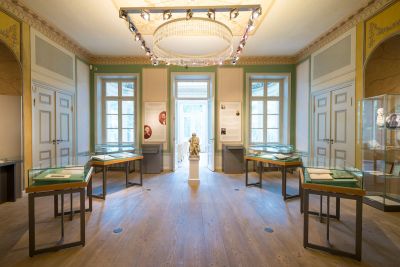Museum
The Museum at Villa Eschenburg
Johannes Brahms was not only a man of sound, but also a man of vision, who had a special affinity for museums and exhibitions. The Swiss writer Joseph Victor Widmann, who accompanied Brahms on several trips to Italy, reports as follows: »Brahms quickly walked through the galleries; wherever his step slowed, you could be sure that a genuine work of art hung or something especially original could be viewed there . . . But sometimes he just lingered alone in front of the painting, because the revelation of pure, high beauty brought tears to his eyes«.
The objects shown in the changing exhibitions that Brahms-Institut has presented since 2004 in the historical spaces of Villa Brahms do not seek to compete with the »revelation of pure, greater beauty« as in a Titian, Raphael, or Michelangelo, but they are still moving in their own way: a view of the personal address book could be touching for the Brahms lover, just as a view of a Brisé fan with Brahms’ signature, his wallet, pictures collected by the composer in visiting card format or even his letters. Above all, the musical manuscripts of the composer fascinate even the untrained eye, for in viewing an original like this, the mysterious moment when a composition is brought to paper comes alive.
But before the Brahms-Institut was able to present an initial cross section of its collection in the show »Johannes Brahms: Zeichen, Bilder, Phantasien« (»Johannes Brahms: Signs, Images, Fantasies«) in 2004, a convincing museum concept needed to be developed and the basic equipment and furnishings such as vitrines, listening stations, and wall panels needed to be financed. We were able to recruit the renowned Cologne exhibition architect Ingrid Bussenius, who made a name for herself with the illumination of the Cologne Cathedral Treasure. She provided an impressive spatial concept and a design for the glass cases and listening stations. Daniel Zerlang-Rösch (Offenbach) is responsible for designing and realizing the lighting using a central ceiling element that takes up formal aspects of the neo-classical moldings. The financing of the initial furnishings was once again made possible with the generous support of the Possehl Stiftung.
An exhibition that is primarily about music has its own laws of presentation. Something essential would be lacking without actual sound reproductions. Brahms himself was already aware of this aspect when he visited a music exhibition together with Widmann in Bologna in 1888 featuring precious manuscripts and old instruments. As can be read in Widmann’s Erinnerungen: »One viewed with the same sense of awe that the believing Catholic has while looking at relics, but felt that an art that is entirely for the ear is quite unsuitable for an exhibition for the eye.« The exhibition concept kept this in mind and responded accordingly. There are four audio stations where the visitor has the opportunity to experience music. This results in a unique situation of visitors being able to listen to the fifth movement of Ein deutsches Requiem and to examine the composer’s manuscript of the piece at the same time.
In 2008, as part of the show »Johannes Brahms – Ikone der bürgerlichen Lebenswelt?« (»Johannes Brahms – Icon of the bourgeouis lifeworld?«), we created an additional exhibition space that documents Brahms’ Vienna apartment in Karlsgasse 4 in photographs. The focus here was placed on the reconstruction of his music room as an example of bourgeois interior from the end of the nineteenth century. The visual program with Bismarck wearing a laurel wreath is just as informative as the portraits of the musicians displayed. Brahms had the bust of Beethoven in the truest sense »at his neck« when sitting at the piano and composing. The music room is especially popular among museum visitors, for it takes a look at Brahms’ own personal characteristics and makes the man behind the great composer seem closer.



